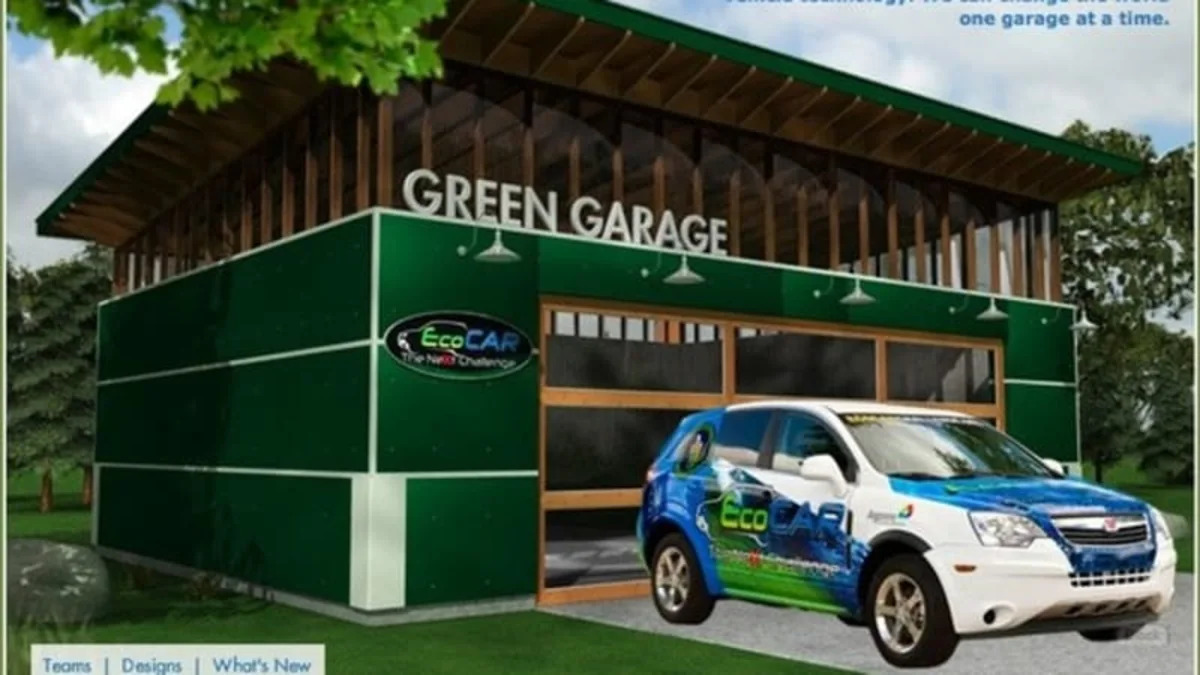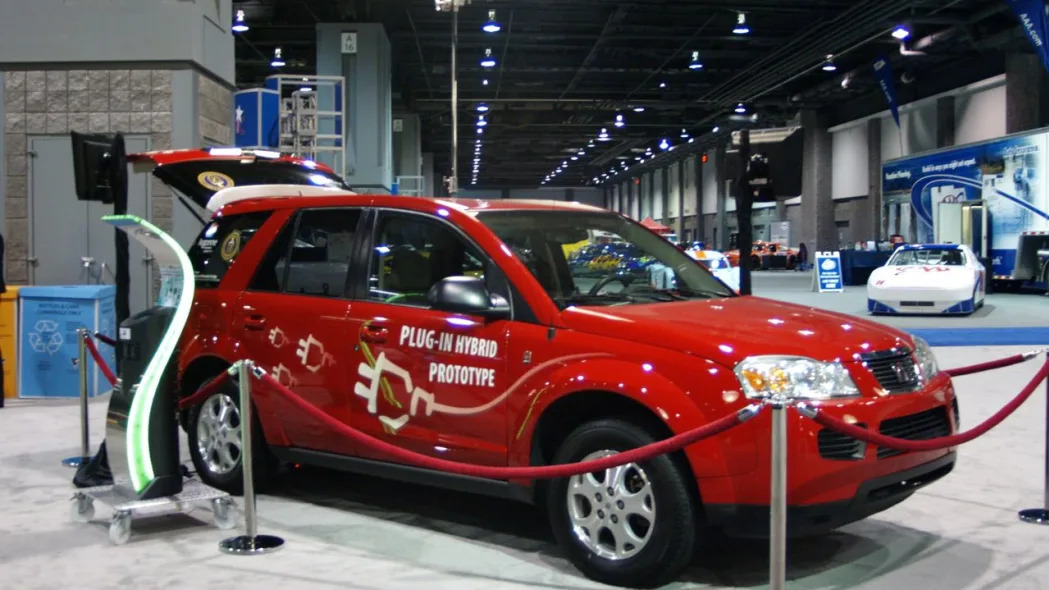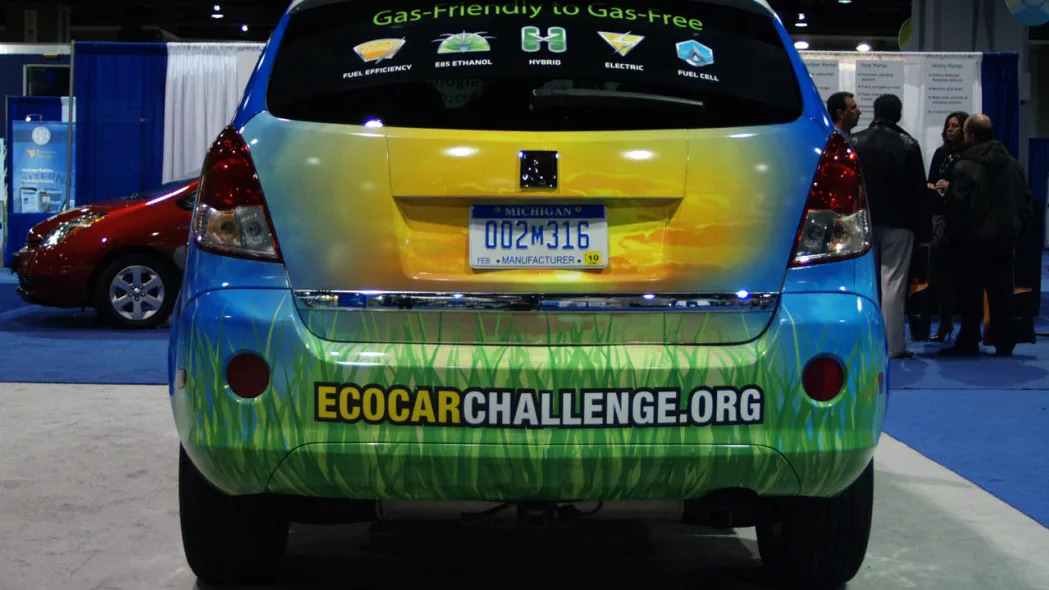Last spring, General Motors wrapped up the fou- year Challenge X program where 17 university teams from the United States and Canada competed to design and build a hybrid drive Chevrolet Equinox. At the conclusion of Challenge X, GM announced that the follow-up competition would be called EcoCar. This time around the teams will be working with Saturn Vues and they will have the option of four different directions they can go with propulsion. Teams can build a plug-in hybrid electric with internal combustion, a fuel cell plug-in hybrid, an extended range EV or a full-function EV with a minimum 100-mile electric range. All the vehicles have to have plug-in capability and retain the performance and safety expected in a modern vehicle. The competition will run for three years and, inspired by the all the inventors that have worked out of garages over the years, the official site for the competition has been name the Green Garage.
[Source: General Motors]
PRESS RELEASE:
'Green Garage' Debuts at Washington Auto Show to Roll out EcoCAR Challenge Designs
Student 'garage innovators' unveil future green vehicle technology solutions at the Washington Auto Show
WASHINGTON - The garage has become an icon of innovation, emblematic of a spirit of invention that has produced some of North America's greatest inventions. Today, at the Washington Auto Show, a next generation of garage innovators emerges, ready to spark new invention, and to do so for the good of the planet and its future generations. This is the Green Garage.
The Green Garage (www.green-garage.org) is a virtual portal, and beyond its doors are 17 teams of emerging innovators that comprise EcoCAR: The NeXt Challenge, an unprecedented public/private partnership that provides invaluable experience and training to the next generation of engineers developing future clean vehicle technology solutions. Today, the 17 EcoCAR teams, selected from universities across North America, unveiled their long-awaited vehicle architectures at the Washington Auto Show.
EcoCAR was established by the U.S. Department of Energy (DOE) and General Motors (GM), and it is sponsored by the Government of Canada, as well as other high-profile sponsors, including the newly announced California Air Resources Board (see today's EcoCAR sponsorship press release for additional information). EcoCAR challenges university engineering students across North America to re-engineer a 2009 Saturn VUE, provided by GM, to achieve improved fuel efficiency and reduce emissions while retaining the vehicle's performance and consumer appeal.
"Our world is experiencing dramatic changes, and we're looking to a next generation of engineers across North America to help spark innovation in the way we design and build vehicle propulsion systems," said Britta Gross, manager, Hydrogen and Electrical Infrastructure Commercialization for General Motors. "This competition allows us to work alongside policy-makers, academia and other industry stakeholders to improve vehicles and increase our knowledge. Our hope is that the Green Garage vision doesn't end with a re-engineered Saturn VUE, but that it endures as an ongoing legacy of innovation through the future careers of these engineering graduates."
Each of the 17 EcoCAR teams will test the boundaries of advanced vehicle design and sustainable mobility. The EcoCAR Challenge isn't focused on one technology or fuel, but instead will test multiple technologies in a variety of combinations. Although each team had proposed specific variations, the teams selected from four design platforms (see today's EcoCAR architecture press release for additional information):
* Full Function Electric Vehicle (FFEV)
A Full Function Electric Vehicle has an all-electric motor powering its drive train and has over 100 miles of range. It stores energy in batteries that can be charged using a home electrical outlet.
* Fuel Cell Plug-in Hybrid Electric Vehicle (FCPHEV)
A Fuel Cell Plug-in Hybrid Electric Vehicle uses an onboard hydrogen fuel cell to either propel the vehicle or recharge a battery pack. The battery pack can be charged using a home electrical outlet. The FCPHEV uses significant battery energy before relying on the fuel cell to extend the range of the vehicle.
* Plug-in Hybrid Electric Vehicle (PHEV)
A Plug-in Hybrid Vehicle refers to a hybrid vehicle that has a large battery. The battery can be recharged by plugging into the wall and the vehicle may operate without using the engine at all. Once the battery is depleted the vehicle can still operate as a regular hybrid.
* Extended Range Electric Vehicle (EREV)
An Extended Range Electric Vehicle demonstrates full performance with an electric powertrain and can extend the range of the vehicle with its on-board fuel storage.
Since September 2008, EcoCAR teams have been following GM's global vehicle development process and using sophisticated software to design their unique clean vehicle architecture. As their designs move from idea to reality, the public can follow their progress and learn about the technologies through the Green Garage. The site will also document the three-year journey, highlighting the testing and evaluation of their prototypes and, ultimately, showcasing their final vehicles.
"The hands-on experience and opportunity to work with cutting-edge technologies are more valuable than I could have ever imagined," said Lynn Gantt, a student competitor from the EcoCAR team at Virginia Tech. "We're actually working with the same technologies and methodologies that GM uses, and this means we're capable of delivering real innovation to the automotive industry during a time when breakthroughs in clean vehicle technology are more important than ever."
While each of the 17 EcoCAR designs is unique, there are common attributes including:
* All of the vehicles have plug-in capability, which can significantly reduce on-road petroleum consumption.
* All of the designs use state-of-the-art lithium ion battery technology, so the vehicles are able to store more electric energy in smaller, lighter packages.
* All of the vehicles use a renewable energy source that displaces petroleum consumption, which significantly reduces the amount of greenhouse gases emitted from the vehicle's tailpipes.
* All of the EcoCAR team architectures must retain the safety and real-world performance characteristics of production vehicles that consumers demand.
To access digital content and the social media press release, please visit: http://pitch.pe/3840.
Background:
EcoCAR is a three-year competition that builds on the 19-year history of DOE advanced vehicle technology competitions by giving engineering students the chance to design and build advanced vehicles that demonstrate leading-edge automotive technologies. During the program, General Motors will provide production vehicles, vehicle components, seed money, technical mentoring and operational support. The U.S. Department of Energy and its research and development facility, Argonne National Laboratory, will provide competition management, team evaluation and technical and logistical support. Through this important partnership between government and industry, EcoCAR aims to inspire and support the next generation of scientists and engineers to unite around the common goal of sustainable mobility.




Sign in to post
Please sign in to leave a comment.
Continue